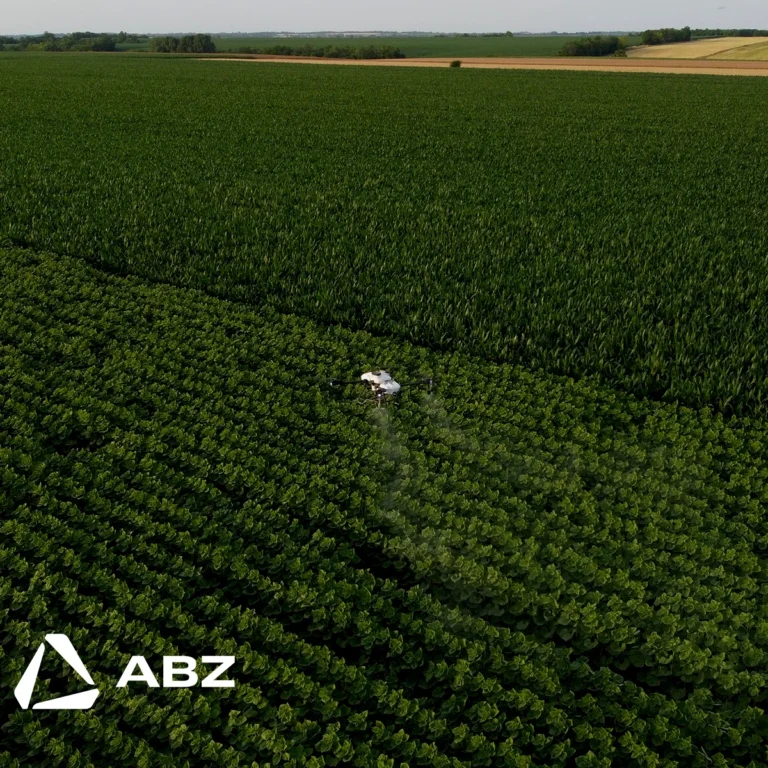ABZ Smart Farm Concept

Introduction
Precision agriculture continues to evolve, and aerial drone technology presents new possibilities. This document outlines a concept for integrating ABZ Innovation’s drone technology into a 250-hectare smart farm operation. Our drone solutions are designed to offer efficiency gains, potential cost savings, and support sustainable practices. This proposal details the required equipment, estimated investment strategy, operational workflow, potential return on investment (ROI) factors, and examples of real-world applications to consider when evaluating drone-based precision farming.
1. The ABZ Innovation Drone Fleet: Features and Capabilities
Our drones are designed and manufactured in the EU, CE certified, and built for agricultural applications. Key features include:
ABZ Sense: A LiDAR system providing real-time terrain following and obstacle avoidance, facilitating operation in varied landscapes. It assists in optimizing flight paths for efficient application.
RTK Accuracy: Both drone models integrate seamlessly with a single Emlid RTK base station, enabling centimeter-level positioning accuracy useful for precise spot spraying and pattern flying.
Advanced Planning: Allows creation of specific flight paths using waypoints. Users can program instructions (altitude, speed, application rate) for targeted treatments, optimized orchard/vineyard navigation, compensation for uneven ground equipment coverage, and specialized greenhouse operations.
Prescription Map Compatibility: Capable of executing spot applications for spraying and spreading based on pre-existing field data maps, allowing inputs to be applied according to defined zones.
Available Models (Relevant to this proposal):
L10 V2:
Capacity: 10L spray tank / Optional 20L spreader tank.
Performance: Sprays up to 10 ha/hour; Spreads up to 440 kg/hour.
Suitable for: Smaller plots, targeted applications, supplementary tasks, specialized biological treatments, vineyard spraying.
L30 V2:
Capacity: 30L spray tank / Optional 50L spreader tank.
Performance: Sprays up to 21 ha/hour; Spreads up to 1100 kg/hour.
Suitable for: Large area coverage, primary spraying/spreading tasks on farms of this scale, intensive orchard spraying, broadacre crops like sunflowers.
2. Equipment Investment Strategy for a 250ha Operation
Understanding Operational Speeds:
While catalogue data indicates maximum performance (e.g., L30 spraying up to 21 ha/hour), real-world speeds are influenced by field shape, terrain, obstacles, and refilling/battery turnaround times. A realistic estimate:
L30 in open fields: ~15 ha/hour
L30 in orchards or vineyards: ~5 ha/hour
L10 will be proportionally slower
Initial Fleet Recommendation (1x L30 V2 + 1x L10 V2):
1 x ABZ Innovation L30 V2: For large area coverage and high-volume tasks
1 x ABZ Innovation L10 V2: For smaller plots, complex areas, spot spraying, biologicals, or parallel operations
Initial Investment Breakdown (RRP pricing):
L30 V2 Package:
Drone: €12,900
4x Batteries: €5,560
Charger: €1,190
Subtotal: €19,650
L10 V2 Package:
Drone: €9,900
4x Batteries: €3,000
Charger: €627
Subtotal: €13,527
Shared Equipment:
1 x Emlid RTK Base Station: €2,500
Optional Spreaders:
1 x 50L Spreader (L30): €1,600
1 x 20L Spreader (L10): €1,600
1 x Trichogramma Spreader (L10): €1,900
Estimated Initial Investment (1x L30 + 1x L10 + RTK):
€35,677 (excluding optional spreaders)
Scaling Strategy:
To increase capacity, the fleet can be expanded to:
2 x ABZ Innovation L30 V2
2 x ABZ Innovation L10 V2
(One RTK base is sufficient)
Estimated Scaled Investment:
€68,854 (excluding optional spreaders)
Operational Costs (Estimates):
L10 V2: ~€0.60/ha
L30 V2: ~€0.90/ha
(Traditional methods: €6–€15/ha)
3. Drone-Based Smart Farming Workflow Outline
Mission Planning:
Define field boundaries within the planning software (existing SHP files can be used)
Upload prescription maps (if used) for spot spraying
Utilize the Advanced Planning tool to create flight paths, setting parameters like altitude, speed, and application rate
Preparation:
Transport equipment (drone, batteries, liquids/granules) to the field
Fill the drone’s tank or spreader hopper
Perform standard pre-flight checks
Execution:
Launch the drone for autonomous mission execution based on the plan
ABZ Sense provides terrain adaptation and obstacle avoidance during flight
Monitor progress via the ground station controller
Swap batteries as needed for continuous operation
Post-Flight:
Review mission logs and application data for record-keeping
Perform routine equipment cleaning and battery charging
4. Potential Advantages & Return on Investment (ROI) Considerations
Resource Management:
Water Use: Potential for significant reduction (field data shows 85–95% reduction in water carrier volume compared to traditional methods)
Chemical Use: Up to 50% reduction through precise application and spot spraying. Biological control options further reduce chemical dependency
Crop & Soil Health:
Reduced Soil Compaction: Drones eliminate ground machine traffic, avoiding compaction and trampling
Operational Aspects:
Coverage Rate: 5–15 ha/hr per drone (depending on terrain), multiplied by the number of units in operation
Operating Cost: Field data shows ~€1–2/ha for drones vs €6–15/ha for traditional
Labor Efficiency: 0.5 workhour/ha vs 3 workhour/ha
Accessibility & Flexibility: Operates in wet, sloped, or tight-field conditions
Precision & Sustainability:
RTK-level accuracy
Lower chemical/water usage
Reduced CO₂ emissions (82% less in vineyard tests)
Zone-specific treatments without full-field application
5. Real-World Applications & Success Stories
Tokaj Vineyards, Hungary:
50% lower cost, 54% less pesticide, 90% less water, 82% less CO₂
Vineyards, Portugal (L10 vs Backpack):
Water: 60 l/ha vs 400 l/ha
Speed: 2 ha/hr vs 0.3 ha/hr
Cost: €2/ha vs €6/ha
Labor: 0.5 vs 3 workhours/ha
Sunflowers, Hungary (L30 vs Tractor):
Water: 15 l/ha vs 300 l/ha
Speed: 25 ha/hr peak (15 avg)
Cost: €1/ha vs €15/ha
Greenhouse Shading:
Application time: 2 hrs/ha vs 6–8 hrs/ha
Water: 333 l/ha vs 1000 l/ha
Citrus Spraying (L30):
Water: 200 l/ha vs 2000 l/ha (90% saving)
CDA system and canopy penetration optimize application (~3 ha/hr in dense crops)
Spreading (L10/L30):
440–1100 kg/hr with 4–9m spread width
Covers difficult terrain, reduces labor and compaction
Biological Pest Control (Trichogramma):
36 ha/hr coverage
Precise release, eco-friendly, pesticide-free
Conclusion
ABZ Innovation drones provide a powerful technological solution to enhance the efficiency, precision, and sustainability of a 250-hectare smart farm. A balanced drone fleet enables flexible, scalable operations and significant input savings. Proven field data and successful applications validate the investment. We are available to explore your specific requirements and provide tailored recommendations for drone-based agricultural solutions.


